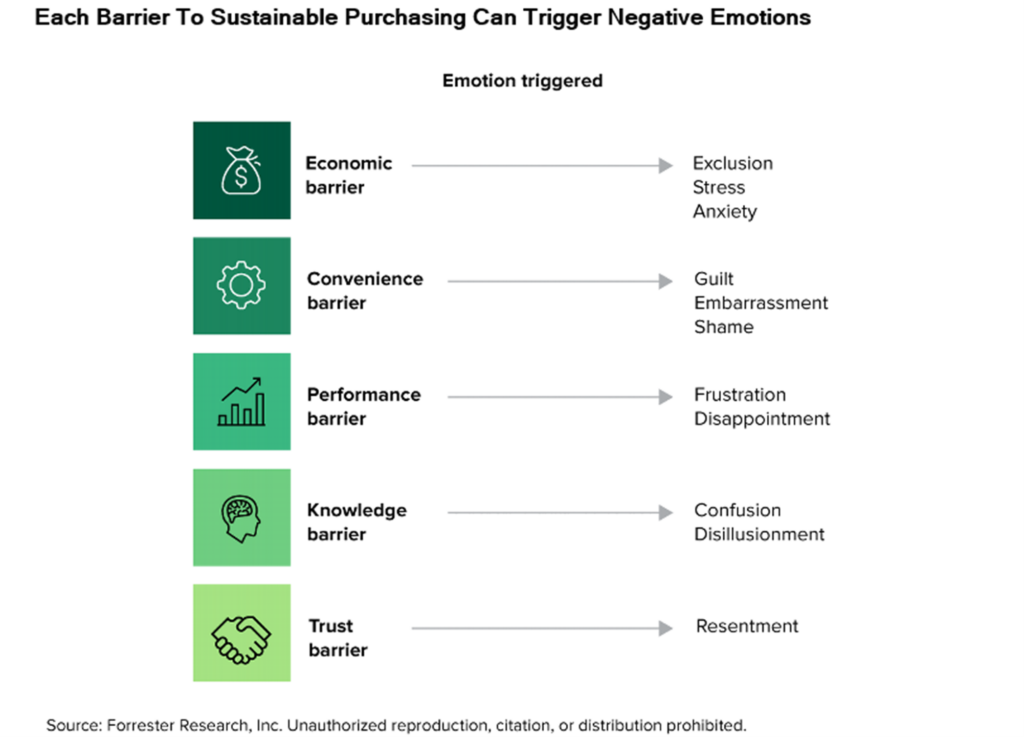We Need To Understand The Emotions That Drive Customers To Make Sustainable Choices
(coauthored by Mélissa Chaudet)
Many consumers want to act sustainably but struggle to do so, for both intrinsic (lack of motivation) and extrinsic (price, convenience) reasons.
Embracing sustainability requires organizations to understand the emotions that drive customers to make sustainable choices and to contextualize sustainability in the customer journey to help customers bridge the gap between their sustainability intentions and actions.
To drive more sustainable customer behavior, customer experience (CX) pros must:
1. Identify barriers to a sustainable lifestyle and the emotions they evoke.
Our research has identified five barriers that impede customers’ green purchasing: price, convenience, performance, knowledge, and trust. Each of these five barriers evokes different emotions.

2. Segment your customers to understand their baseline emotions.
Who is on the journey? Is it a consumer concerned about climate change who places a high premium on acting sustainably over objectives like price and convenience? Is it an environmental activist distrustful of your environmental claims? Or is it a less environmentally aware consumer feeling overwhelmed, lazy, skeptical, or even indifferent? Designing for these segments and their emotions, such as guilt versus pride versus resentment, is quite different.
3. Make sustainability tangible by contextualizing it in the customer journey, and design for a broader spectrum of emotions to drive sustainable choices.
We need to stop thinking of sustainability journeys as separate from customers’ goals. We need to understand the journeys that customers are on, the goals they are trying to accomplish, and the steps they take to accomplish those goals. Embed sustainability into micro moments in common journeys, such as “I am buying my weekly groceries (and I want to reduce my consumption of meat and plastic)”; “I am buying a new winter coat (and I would rather buy secondhand or increase the longevity of my current winter coat)”; or “I am renovating (and I want to buy furniture that is made from sustainable materials).”
And we need to design for a broad spectrum of emotions that drive sustainable choices. We typically have a poor understanding of the emotions that drive great CX and sustainable action. Below are some tips from our research to help you design for sustainable action:
- Prioritize confidence and trust. Only 34% of Europe-5 consumers trust companies when they say they will commit to reducing climate change. Trust is one of the five key barriers to consumers acting sustainably. Sustainability filters (which can be set to values like animal welfare, reuse of materials, and water conservation), Eco-Score labeling, and transparent pricing (broken down by costs for materials, labor, transport, etc.) help increase trust and confidence.
- Acknowledge the negative emotions that get in the way. Focusing on guilt, fear, and anxiety won’t motivate customers to make sustainable choices, but don’t ignore the negative emotions that get in the way of sustainability, such as apathy, indifference, and helplessness. Help customers believe that their sustainable choices matter and make a difference, and make sustainable choices the default to counteract feelings of withdrawal or insignificance.
- Embrace paradoxical emotions. Customers will experience paradoxical emotions like confidence and guilt, for instance, when making trade-offs between functional performance and sustainability. By highlighting elements like quality and speed as much as sustainable features like recyclability, brands help customers overcome concerns about product performance.
- Help customers recall emotions to shape sustainable choices. Recalling feelings of pride associated with a past sustainability-related behavior increases customers’ sustainable purchase intentions compared with a neutral emotional recall. Customers can experience both anticipated pride at the prospect of a sustainable behavior choice and anticipated guilt if their future choice isn’t sustainable.
For more information, see the full Forrester report or schedule an inquiry with us.
